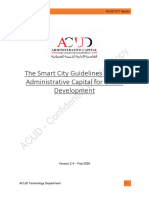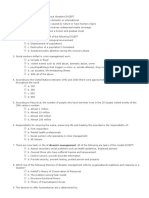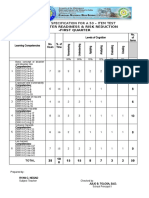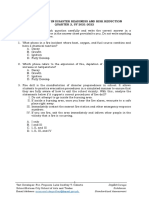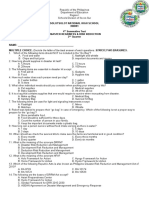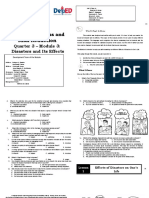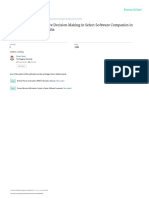0 ratings0% found this document useful (0 votes)
81 views3rd Quarter DRRR Exam
3rd Quarter DRRR Exam
Uploaded by
John Aries Asiao PaguiriganThis document appears to be a test on disaster readiness and risk reduction topics. It contains 50 multiple choice and true/false questions testing knowledge on hazards, the disaster management cycle, vulnerability, capacity, and first aid. It also includes sections requiring the enumeration of signs and symptoms of fainting and wounds, as well as characteristics of a good first aider. The test covers a wide range of concepts related to disaster preparedness and emergency response.
Copyright:
© All Rights Reserved
Available Formats
Download as DOCX, PDF, TXT or read online from Scribd
3rd Quarter DRRR Exam
3rd Quarter DRRR Exam
Uploaded by
John Aries Asiao Paguirigan0 ratings0% found this document useful (0 votes)
81 views2 pagesThis document appears to be a test on disaster readiness and risk reduction topics. It contains 50 multiple choice and true/false questions testing knowledge on hazards, the disaster management cycle, vulnerability, capacity, and first aid. It also includes sections requiring the enumeration of signs and symptoms of fainting and wounds, as well as characteristics of a good first aider. The test covers a wide range of concepts related to disaster preparedness and emergency response.
Original Description:
drrr
Original Title
3rd quarter DRRR exam
Copyright
© © All Rights Reserved
Available Formats
DOCX, PDF, TXT or read online from Scribd
Share this document
Did you find this document useful?
Is this content inappropriate?
This document appears to be a test on disaster readiness and risk reduction topics. It contains 50 multiple choice and true/false questions testing knowledge on hazards, the disaster management cycle, vulnerability, capacity, and first aid. It also includes sections requiring the enumeration of signs and symptoms of fainting and wounds, as well as characteristics of a good first aider. The test covers a wide range of concepts related to disaster preparedness and emergency response.
Copyright:
© All Rights Reserved
Available Formats
Download as DOCX, PDF, TXT or read online from Scribd
Download as docx, pdf, or txt
0 ratings0% found this document useful (0 votes)
81 views2 pages3rd Quarter DRRR Exam
3rd Quarter DRRR Exam
Uploaded by
John Aries Asiao PaguiriganThis document appears to be a test on disaster readiness and risk reduction topics. It contains 50 multiple choice and true/false questions testing knowledge on hazards, the disaster management cycle, vulnerability, capacity, and first aid. It also includes sections requiring the enumeration of signs and symptoms of fainting and wounds, as well as characteristics of a good first aider. The test covers a wide range of concepts related to disaster preparedness and emergency response.
Copyright:
© All Rights Reserved
Available Formats
Download as DOCX, PDF, TXT or read online from Scribd
Download as docx, pdf, or txt
You are on page 1of 2
NORTHILLS COLLEGE OF ASIA (NCA), INC.
Maharlika Highway, Brgy. Bautista, Labo, Camarines Norte
CP No.: 09182050673
Senior High School
Disaster Readiness and Risk Reduction
3rd Quarter Examinations
NAME: _____________________________________ SCORE :_________________
STRAND/SECTION:_______________ ___ DATE:__________________
I. Instruction: Read each item carefully. Encircle that corresponds to the letter of you answer. Remember:
ERASURE MEANS WRONG.
1. What type of hazard are landslides?
a. Anthropogenic b. Geologic c. Biological d. Hydrometeorological
2. What type of hazard is typhoon?
a. Anthropogenic b. Geologic c. Biological d. Hydrometeorological
3. Which phase of the emergency management cycle should the government focus most of its resources?
a. Preparedness b. Recovery c. Prevention & mitigation d. Response
4. What kind of activity under the response or recovery phase is focused on re-establishing essential services?
a. Development b. Rehabilitation c. Reconstruction d. Relief
5. Which phase of the disaster management cycle is concerned with actions to anticipate effectively, respond to and
recover from the impacts of an imminent disaster?
a. Preparedness b. Recovery c. Prevention & mitigation d. Response
6. Which of the following metric is mainly concerned about economic, environmental, physical and social factors?
a. Disaster risk b. Hazard c. Exposure d. Vulnerability
7. Which of the following metric is mainly concerned about the situation of people, infrastructure, housing, and other
tangible human assets located in hazard-prone areas,
a. Disaster risk b. Hazard c. Exposure d. Vulnerability
8. Which of the following is NOT a characteristic of disaster risk?
a. Forward looking b. Static and unchanging c. Emergent and complex d. Unevenly
distributed
9. Which of the following is NOT activated during the response phase of the emergency management cycle?
a. Emergency Action Plan b. Incident Action Plan c. Incident Command System d. None of the
above
10. A deep earthquake occurred far from a city and the buildings were exposed to earthquake waves with low frequency.
Which building would you expect to have the most damage?
a. 2-storey building b. 10-storey building c. 18-storey building d. 26-storey building
11. Which of the following is not a factor in the formation of a thunderstorm?
a. Moist environment b. Unstable environment c. Strong winds d. Vertical motion
12. A student is left in their house along with her younger siblings during one weekend. She noticed that their sofa is on
fire and it seemed that it has been burning for about a minute. Which should she do first?
a. Use the fire extinguisher since the fire is still small
b. Find her younger siblings and make sure they leave the house
c. Call 911 immediately and notify the fire department
d. Evacuate immediately and hope that her siblings will also notice the fire.
13. A serious disruption of the function community or a widespread human, material, economic, or environmental
losses.
a. Disaster b. Vulnerability c. Disaster risk d. Hazard
14. It is chance or likelihood of suffering harm and loss as a result of a hazardous event.
a. Vulnerability b. Disaster c. Disaster Risk d. Hazard
15. Disaster is frequently described as a result of various condition except _______.
a. Exposure to hazard b. Conditions of vulnerability c. Having enough physical, social, and
attitudinal capabilities d. insufficient capacity or measures to cope with disasters.
16. It is a situation or occurrence with capacity to bring damages to lives, properties, and the environment.
a. Hazard b. Element at risk c. Capacity d. Vulnerability
17. Which can’t be prevented but can be anticipated generally?
a. Human-made hazards b. Disasters c. Socionatural Hazards d. Natural Hazards
18. Which can frequently be prevented and anticipated?
a. Human-made hazards b. Disasters c. Socionatural Hazards d. Natural Hazards
19. Which is considered as Socionatural Hazard?
a. Flooding and drought b. Environmental degredation c. Chemical Contamination d. Volcanic
eruption
20. Which group belongs to the most vulnerable?
a. Professionals b. Indigenous people c. Government d. Small entrepreneurs
21. Which is/are classified as physical/material vulnerability?
a. family structure b. leadership qualities c. land and water d. initiative
22. Which is classified as social/organizational vulnerability?
a. Fatalism b. Leadership qualities c. land and water d. initiative
23. Which is classified as economic vulnerability?
a. Fatalism b. Leadership qualities c. soil quality d. family structure
24. It refers to, ‘’all strengths, attributes and resources available within a community, organization, or society that can
be used to achieve an agreed goal.’’
a. vulnerability b. capacity c. rehabilitation d. mitigation
25. It refers to, ‘’the ability of people, organizations, and systems, using available skills, and resources, to face and
manage adverse conditions, emergencies or disasters.’’
a. coping capacity b. capacity c. rehabilitation d. mitigation
II. True or False. Read the following statement and write TRUE if the statement is correct and write FALSE if it
is wrong. Write your answer in the space provided.
_______________26. Tsunami resembles the low tides which led to being falsely called" tidal waves".
_______________27. Tectonic earthquake is triggered by volcanic activity near the surface.
_______________28. First Aid is an immediate care given to a person/victim who has suddenly become ill or has been
injured.
_______________29. Fainting caused by a sudden fall in the supply of blood to their brain that results in the temporary
loss of consciousness.
_______________30. Bandages have three key uses: applying pressure to bleeding wounds; covering wounds and
burns; and providing support and immobilization for broken bones, sprains, and strains. These includes gauze, triangular,
Elastic, and tubular bandage.
III. ENUMERATION TEST
Directions: List down or enumerate what are being asked on each of the following item.
(31-36) Sign & Symptoms of FAINTING
IV. ENUMERATION TEST
V. Directions: List down or enumerate
what are being asked on each of the
following item
31.
32.
33.
34.
35.
36.
(37-39) Classification of WOUNDS
37.
38.
39.
(40-47) Sign & Symptoms of WOUNDS
40.
41.
42.
43.
44.
45.
46.
47.
(48-50) Characteristics of a Good First Aider
48.
49.
50.
ENUMERATION TEST
Directions: List down or enumerate what are
being asked on each of the following item
You might also like
- Sop Bme GPHDocument30 pagesSop Bme GPHPranali MhatreNo ratings yet
- ACUD Smart City Code 2.4Document36 pagesACUD Smart City Code 2.4Khaled MamdouhNo ratings yet
- SMART REPORT 2019 Final PDFDocument76 pagesSMART REPORT 2019 Final PDFShylet Anesu JongaNo ratings yet
- DRRR - Q2 - Summative 3Document4 pagesDRRR - Q2 - Summative 3Billy Jasper DomingoNo ratings yet
- DRRR ReviewerDocument8 pagesDRRR ReviewerCatherine ManaloNo ratings yet
- DRRR Q1 Midterm ExamDocument2 pagesDRRR Q1 Midterm ExamJeffrey OralizaNo ratings yet
- DRRR q1 Mod2 Riskfactorsunderlyingdisasters V2Document26 pagesDRRR q1 Mod2 Riskfactorsunderlyingdisasters V2Paolo jose cortezNo ratings yet
- Midterm Assessment For 3RD Quarter2Document4 pagesMidterm Assessment For 3RD Quarter2Erumi ShidouNo ratings yet
- DRRR 4TH Quarter Exam.Document4 pagesDRRR 4TH Quarter Exam.Faxman Cavan SingcoNo ratings yet
- Disaster Readiness and Risk Reduction - Grade 12Document5 pagesDisaster Readiness and Risk Reduction - Grade 12Rizalyn GarciaNo ratings yet
- Disaster Readiness & Risk Reduction (4 Quarter Reviewer) : Southwest MonsoonDocument4 pagesDisaster Readiness & Risk Reduction (4 Quarter Reviewer) : Southwest MonsoonFeiweibei SongNo ratings yet
- Disaster Risk Reducation - Reviewer EXAM PDFDocument2 pagesDisaster Risk Reducation - Reviewer EXAM PDFElectona Kai SairNo ratings yet
- Summative 1Document3 pagesSummative 1Shallie Ciudadano TumbagaNo ratings yet
- NAME: - COURSE/SECTION: - SCORE: Long Quiz in DRRRDocument3 pagesNAME: - COURSE/SECTION: - SCORE: Long Quiz in DRRRRenz GaraisNo ratings yet
- DRRR Midterms ReviewerDocument16 pagesDRRR Midterms ReviewerHans Matthew AntiojoNo ratings yet
- MODULE 3 Hydrometeorological HazardsDocument2 pagesMODULE 3 Hydrometeorological Hazardsanjero hortelano0% (1)
- SUMMATIVE TEST 2 DRRR 4th QuarterDocument5 pagesSUMMATIVE TEST 2 DRRR 4th Quarterjovy dulay100% (1)
- On Disaster Readiness & Risk Reduction - First Quarter: Table of Specification For A 50 - Item TestDocument4 pagesOn Disaster Readiness & Risk Reduction - First Quarter: Table of Specification For A 50 - Item TestLiezel CauilanNo ratings yet
- Lagro Campus Quarter Exam in Disaster Readiness and Risk ReductionDocument2 pagesLagro Campus Quarter Exam in Disaster Readiness and Risk ReductionAJ CarranzaNo ratings yet
- 4thQ Summative Test 1Document2 pages4thQ Summative Test 1aljon julian100% (1)
- Disaster Readiness and Risk Reduction: Quarter 1 - Module 3: Disasters and Its EffectsDocument23 pagesDisaster Readiness and Risk Reduction: Quarter 1 - Module 3: Disasters and Its EffectsJerome A. Gonzales100% (1)
- 3rd DRRR EXAMDocument2 pages3rd DRRR EXAMMary Jane Tamondong Baniqued100% (2)
- Name: - Section: - Date: - ScoreDocument4 pagesName: - Section: - Date: - ScoreBRENDEL SACARISNo ratings yet
- DRRM - 1st Long QuizDocument3 pagesDRRM - 1st Long QuizFrancis BernalesNo ratings yet
- DRR11Document8 pagesDRR11Llermi Liborio100% (1)
- DRR 12 1st Long TestDocument3 pagesDRR 12 1st Long TestRoy CanoyNo ratings yet
- DRRR G11Document10 pagesDRRR G11Mark John GuardamanoNo ratings yet
- First Summative Test DRRR 4th Quarter New NormalDocument2 pagesFirst Summative Test DRRR 4th Quarter New NormalRenzelle Guilaran GerocheNo ratings yet
- Quarter 1 Exam - DRRRDocument4 pagesQuarter 1 Exam - DRRRKevin Arnaiz100% (1)
- DRRR Handout Volcanic HazardDocument4 pagesDRRR Handout Volcanic HazardAnonymous fKViHeaw0% (1)
- DRRM ACT 1 and 2 Elements of FireDocument2 pagesDRRM ACT 1 and 2 Elements of FireHugsNo ratings yet
- DRRR Activity Sheet 34Document4 pagesDRRR Activity Sheet 34Sam Kim 3No ratings yet
- 1st Quarter ExamDocument3 pages1st Quarter Examrheza oropaNo ratings yet
- Project Concept Paper Activity1 1Document8 pagesProject Concept Paper Activity1 1B2 Laza Justine PeterNo ratings yet
- DRRR - Module6 (Week10-11)Document19 pagesDRRR - Module6 (Week10-11)starlightzNo ratings yet
- Sim DRRM Melc Q1 Week 2 L4 5 - 24 PDFDocument24 pagesSim DRRM Melc Q1 Week 2 L4 5 - 24 PDFVital Mark ianNo ratings yet
- DRRR - Q2 - Summative Test 3Document9 pagesDRRR - Q2 - Summative Test 3Propsero Luke Godfrey CaberteNo ratings yet
- 20171206141215tutorial 1 - Chapter 1 and 2 - SchemeDocument5 pages20171206141215tutorial 1 - Chapter 1 and 2 - SchemeShahNo ratings yet
- DRRR 11 12 Ic 7Document3 pagesDRRR 11 12 Ic 7ben leeNo ratings yet
- Test Questionnaire - DRRRDocument3 pagesTest Questionnaire - DRRRAlbert Rosete100% (1)
- DRRR LAS Q1 W1 2nd Sem SY 2020 2021Document1 pageDRRR LAS Q1 W1 2nd Sem SY 2020 2021Mark Allen LabasanNo ratings yet
- PPPR4Document2 pagesPPPR4Pearl Cabigas0% (1)
- Test Questionnaire Disaster Readiness and Reduction 3rd QuarterDocument4 pagesTest Questionnaire Disaster Readiness and Reduction 3rd QuarterzhaninakayeNo ratings yet
- DRRR Q2 Exam TOS 20 ItemsDocument2 pagesDRRR Q2 Exam TOS 20 ItemsJeffrey OralizaNo ratings yet
- Natural Signs Impending Tsunami: Disaster Readiness and Risk ReductionDocument24 pagesNatural Signs Impending Tsunami: Disaster Readiness and Risk ReductionGian Carlo PreNo ratings yet
- Name: - Score: - Year and Section: - DateDocument2 pagesName: - Score: - Year and Section: - DateEmerson Mercado GalanoNo ratings yet
- DRRR Learning Material 1.0Document23 pagesDRRR Learning Material 1.0Jesser Mae BarocNo ratings yet
- DRRR PPT Unit 9 (B) PDFDocument38 pagesDRRR PPT Unit 9 (B) PDFAaron MirandaNo ratings yet
- 1st Quarter Exam in DRRRDocument3 pages1st Quarter Exam in DRRRNelmar Araneta100% (1)
- Summative Test DRRR (4th ST-2nd Q)Document2 pagesSummative Test DRRR (4th ST-2nd Q)Kennedy Fieldad Vagay100% (2)
- DRR11 12 Ic D 34Document3 pagesDRR11 12 Ic D 34allanrnmanalotoNo ratings yet
- DRRRDocument2 pagesDRRRJoyce Dela Rama JulianoNo ratings yet
- DRRRDocument2 pagesDRRRJoyce Dela Rama JulianoNo ratings yet
- 3rd Monthly Exam g11Document4 pages3rd Monthly Exam g11fe janduganNo ratings yet
- 3rd Final ExamDocument9 pages3rd Final ExamMira Verano100% (1)
- DRRRDocument17 pagesDRRRPatrick L. RondinaNo ratings yet
- Midterms PHILOSOPHY 1Document3 pagesMidterms PHILOSOPHY 1Marvin PameNo ratings yet
- DRRR Reviewer 3rd QuarterDocument8 pagesDRRR Reviewer 3rd QuarterApril Joy T. GrijaldoNo ratings yet
- Disaster Readiness and Risk Reduction: Quarter 3 - Module 3: Disasters and Its EffectsDocument7 pagesDisaster Readiness and Risk Reduction: Quarter 3 - Module 3: Disasters and Its Effectsrhubby joy alivioNo ratings yet
- Blessed Christian School de Sta. Rosa Inc.: Rizal Blvd. Balibago, City of Santa Rosa SY: 2019-2020Document4 pagesBlessed Christian School de Sta. Rosa Inc.: Rizal Blvd. Balibago, City of Santa Rosa SY: 2019-2020Angelyn LingatongNo ratings yet
- DRRR G12Document6 pagesDRRR G12JERVIN JESALVANo ratings yet
- PRELIM EXAM-DISASTER - Docx2Document8 pagesPRELIM EXAM-DISASTER - Docx2Irene Lopez100% (3)
- Mid Term Exam 2022 2023 H. CapellanDocument6 pagesMid Term Exam 2022 2023 H. CapellanMike Lawrence CadizNo ratings yet
- Tecnadyne PC6XDocument1 pageTecnadyne PC6Xdegek68399No ratings yet
- Cybersecurity+for+Industry+4 0 PDFDocument273 pagesCybersecurity+for+Industry+4 0 PDFMuhammad Machbub Rochman100% (2)
- Lindell V Dominion Smartmatic Exhibit 9Document69 pagesLindell V Dominion Smartmatic Exhibit 9UncoverDCNo ratings yet
- How To PlanDocument37 pagesHow To Planaurorashiva1No ratings yet
- FVCC Fire Rescue: Ropes and KnotsDocument72 pagesFVCC Fire Rescue: Ropes and KnotsHackNo ratings yet
- Set Theory: Basic, Essential, and Important Properties of SetsDocument48 pagesSet Theory: Basic, Essential, and Important Properties of SetsRusheel Chava100% (1)
- Jeff Bezos: The Best EntrepreneurDocument7 pagesJeff Bezos: The Best EntrepreneurAnwaar SafdarNo ratings yet
- Listening Activities ClothesDocument6 pagesListening Activities ClothesLaura JeanNo ratings yet
- The Artisan Food Entrepreneur - Jo PackhamDocument178 pagesThe Artisan Food Entrepreneur - Jo PackhamIoanLiutNo ratings yet
- WGC 2015 Paper On Geochem ModelingDocument8 pagesWGC 2015 Paper On Geochem Modelingangcoy.ecNo ratings yet
- Archaeology Anthropology and Interstellar Communication TAGGEDDocument330 pagesArchaeology Anthropology and Interstellar Communication TAGGEDphphdNo ratings yet
- Advanced Technology Vehicle Lab Benchmarking - Level 2 (In-Depth)Document15 pagesAdvanced Technology Vehicle Lab Benchmarking - Level 2 (In-Depth)MRafayAmjadNo ratings yet
- How To Apply For Uttarakhand Gramin BankDocument1 pageHow To Apply For Uttarakhand Gramin BankRakesh JhaNo ratings yet
- ISA 510 Initial Audit Engagements ISA 402Document8 pagesISA 510 Initial Audit Engagements ISA 402cynthiama7777No ratings yet
- 〈1229.3〉 MONITORING OF BIOBURDENDocument3 pages〈1229.3〉 MONITORING OF BIOBURDENWendy Joanna Zumba AlvaradoNo ratings yet
- 5-PTN Trouble ShootingDocument53 pages5-PTN Trouble Shootingfarhan9125No ratings yet
- Guitar Songs With ChordsDocument45 pagesGuitar Songs With Chordsjohn vargasNo ratings yet
- Langiden Abra ES2016 2-UnlockedDocument9 pagesLangiden Abra ES2016 2-UnlockedJ JaNo ratings yet
- GEConWorld CieloDocument7 pagesGEConWorld CieloRuth VirtudazoNo ratings yet
- Record Keeping and Grading SoftwareDocument10 pagesRecord Keeping and Grading SoftwareWaseem Khan63% (8)
- Business Letters: A. HeadingDocument11 pagesBusiness Letters: A. HeadingMNo ratings yet
- HRIS As A Tool For Effective Decision Making in Select Software Companies in Bangalore Karnataka India.Document19 pagesHRIS As A Tool For Effective Decision Making in Select Software Companies in Bangalore Karnataka India.Ayanle Ibrahim AhmedNo ratings yet
- PTD Presentation SlidesDocument20 pagesPTD Presentation SlidesManzoorKhanNo ratings yet
- Inventory System FDocument54 pagesInventory System FHappy chishalaNo ratings yet
- Year 5 English Portfolio BelowDocument21 pagesYear 5 English Portfolio Belowapi-265609825No ratings yet
- Module 3 - BreakevenDocument2 pagesModule 3 - BreakevenBern Austin EsguerraNo ratings yet
- Cyst-Oral-Maxillofacial-Regions 10626 0Document35 pagesCyst-Oral-Maxillofacial-Regions 10626 0Irzam PratamaNo ratings yet

